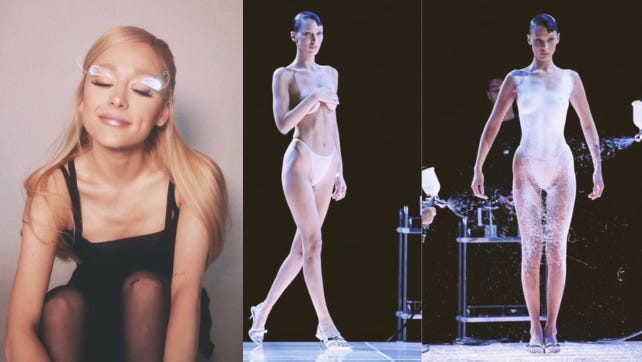You Should Be Romanticizing Your Hormonal Health
As is the case with a luxury car, if you’re supposed to fill the tank with premium fuel but you try to use diesel, the car isn’t going to run quite right.
If I could advise any young gal or guy to do just one simple thing in the effort to improve their health and wellness, it would be to check on their hormone levels.
Get some hormonal blood work done. It’s worth it.
Look, I’m no doctor but I do know that too many people struggle with latent hormonal imbalances that affect their body weight, libido, energy, mood, and of course… fertility. And it’s not just women.
When I first began my journey of detoxing off of hormonal birth control, I was beyond confused by all the endocrine system’s intricacies. But if you do check your hormone levels, you can better identify critical imbalances early – and your trusted healthcare provider can put you down the path for timely treatment.
One in eight women will develop a thyroid disorder at some point in their lives.
More men under 40 are experiencing low testosterone than ever in recorded history.
We mess with our hormones (intentionally and unintentionally!) in so many ways that can affect our day-to-day quality of life and our ability to naturally conceive.
Bloodwork to figure out if you’ve even got imbalances in the first place are one thing… but, there are ways you can combat these bodily stressors
Last year, I penned a piece for my pal Rocky’s WarKitchen magazine titled “You Should Be Romanticizing Your Hormonal Health” because, generally speaking, people have major gaps in knowledge for endocrine wellness.
And I’m talking to you! YOU should be romanticizing your hormonal health. Keep reading to find out why, and get my tried-and-true product recommendations for reducing endocrine system disruption…
Women’s Hormonal Health is the First Indicator of Overall Well-Being
A woman’s menstrual cycle may not be the prettiest topic to talk about, but it's one that often gets overlooked–despite menstrual health essentially being one of women's most critical vital signs. Indeed, whether or not a woman is having regular, healthy menstrual cycles (when not pregnant or post-menopausal, of course) is an objective measurement of her essential physiological function.
Why in the world are we misled to dread our periods when we should really be romanticizing this elegant, purification process which our bodies are instinctively built to go through? Disrupt Mother Nature’s natural rhythms and you’ll find that a lot more in life ends up totally off beat.
But, what is Mother Nature’s divine design?
In general, natural cycles look like 21 days on and then seven or so days off. During those seven days (Day 21 to 35), a woman’s body is readying itself for pregnancy (whether she’s actively babymaking or not) first by her ovaries releasing an egg and then by her uterine lining thickening and cervical mucus changing to prepare for a fertilized egg to be implanted. This is the ovulatory phase where a woman is at peak fertility and genuinely her hottest. No sperm to fertilize the egg? Day one of her menstrual cycle begins where her body releases that thickened uterine lining.
Optimal hormonal health for women is largely determined by the unaffected ebbs and flows of natural estrogen and progesterone, though testosterone does play a part too.
Estrogen peaks around Day 10 to Day 17 and these elevated levels are necessary for heart health, cognitive function, bone density, muscle mass, insulin sensitivity, and our general mood and disposition. Progesterone peaks around Day 21 as the dominant post-ovulation hormone and it shelters a woman’s body from androgens, improves hair, skin, and nail health, decreases breast cancer risk, and improves sleep quality and mood.
When a woman goes on hormonal birth control, she’s cutting herself off from Mother Nature’s natural rhythms and allowing artificial hormones to guide her body’s instinctive processes. Instead of guiding, however, synthetic estrogens and progesterones disrupt them.
Hippocrates Once Said to Let Food be Thy Medicine
As is the case with a luxury car, if you’re supposed to fill the tank with premium fuel but you try to use diesel, the car isn’t going to run quite right. The same principle applies for women’s hormonal health, whether that “fuel” is a woman pumping synthetic hormones through her reproductive and endocrine systems or by not fueling her body quite right with nourishing macros and micros which encourage her body’s natural cycling.
During the life-giving menstrual phase where a woman’s body is intensely detoxifying, there are a few critical nutrients that may be overlooked. Is it any wonder why so many women struggle with painful PMS symptoms around this time?
The most glaringly obvious nutrient needed at this time is magnesium which relaxes muscles and alleviates period pain. Magnesium-rich foods such as pumpkin seeds, chia seeds, flax seeds, almonds, spinach, dark chocolate, legumes, oily fish, and avocado should be high up on a woman’s menstrual phase shopping list.
It almost goes without saying that women are in dire need of iron support while we’re bleeding–most women will only lose around 30 to 50 ml of blood but some can lose up to 80 ml. Beef, lamb, veal, and liver are the most bioavailable and nutrient-dense forms of iron supplementation through diet, but if red meat isn’t on the menu, oysters, sardines, and eggs can and should be.
One of the hardest pills for a young woman to swallow in our figure-focused, diet culture is that she absolutely needs to increase her quality fat intake to best protect fertility. We’re misled to believe that powdered peanut butter is a proper substitute for the real deal because it keeps our waistlines trim.
We’re given visual warfare in the form of borderline anorexic bodies decorated in high fashion editorial spreads. But, healthy fats prevent anovulation and ease symptoms of hormonal imbalances so even though they may not seem like the best bikini season selections, it’s critical to load up on avocados, nut butters, and fatty fish like salmon.
During the follicular phase, women should be prioritizing bodily equilibrium to recover from menstruation. What better–and more deliciously life-giving–way to maintain homeostasis but by supporting good gut bacteria through fermented foods? Tangy, tart sauerkraut or kimchi, smooth, creamy greek yogurt or skyr, or fizzy, effervescent beverages like kombucha or kvass are wonderful for this. Furthermore, women need quality carbs from cruciferous, crunchy vegetables to keep the rest of the bodily functions moving smoothly and to modulate estrogen.
When a woman reaches her ovulatory phase, her estrogen and testosterone levels are at their highest. Whether actively trying to conceive or not, it’s important to eat foods that naturally contain B vitamins because of their role in promoting safe conception, boosting energy, and producing the next wave of red blood cells. This is where a vegan diet can complicate things, as most vegans end up vitamin B deficient and require artificial supplements. It’s in a woman’s best interest to naturally get her B12 from beef, sardines, clams, liver, and dairy, her B6 from milk, salmon, tuna, and eggs, and her folate from dark, leafy greens, beans, sunflower seeds, and quality whole grains.
Finally, in the luteal phase, a woman shouldn't forget to ensure her digestive tract is getting enough quality fiber. Cabbage, cauliflower, apples, nuts, and seeds are very important to boosting fiber intake naturally, but there are many other types of soluble grain and fruit fiber that can help with this.
Cute Cosmetics and Fancy Femcare Contain Hidden Toxins
We can’t control everything around us, but endocrine disruptors are a very real cause of women’s increasingly common hormonal issues from hypothyroidism to low libido to infertility. Some environmental endocrine disruptors may be unavoidable, but there are many within our most popular femcare products and cosmetics alike which should be reduced or outright avoided if we’re really looking to decrease our chemical load. Please note that this is not an exhaustive list of all endocrine disrupting chemicals, as there are sadly too many to include!
One of the first, smartest swaps is to ditch antiperspirants and start using natural deodorants. Antiperspirants contain aluminum chloride which disrupts estrogen function and could even contribute to breast cancer growth. Struggling to find a natural deodorant that doesn’t leave you sweaty or honestly somewhat stinky after a few hours? My tried and true choice is Salt and Stone’s extra strength natural deodorants which come in amazing scents like santal and vetiver, neroli and shiso leaf, or bergamot and hinoki.

Women should also try to steer clear of cosmetics that contain talc, an endocrine disruptor that may actually be linked to ovarian cancer. Sadly, many eyeshadows, blushes, highlighters, bronzers, loose and pressed face powders, liquid foundations and concealers use this asbestos-like product. Instead, double check cosmetics labels to see if they use mica, rice powder, or corn starch. One of my personal favorites is Physicians Formula (their highlighter gives my cheekbones such dreamy, fairy-like strobing effects) but MILK Makeup, Glossier, Kosas, and Pacifica are also commercially available talc-free brands.
Phthalates, notoriously known as the “everywhere chemical,” are in most common household products from food storage containers to shower curtains to nail polish to detergents and more. However, femcare products like tampons, pads, and even period underwear have been found to have higher occurrences of phthalates than other consumer plastics! Look, it’s going up in a pretty sensitive area so it’s probably in a woman’s best interest to keep this multifaceted endocrine disruptor far away from her reproductive system. I’m a big fan of femcare company Garnuu, which sells clean period products and empowers women to take control of their natural cycles.
Again, I could go on and on about the other endocrine disrupting chemicals found in things like soaps, lotions, shampoos and conditioners, and perfumes such as BHA/BHT (skincare products), ethanol (perfumes, toners, acne products), or PABA (chemical sunscreen) but the list just gets too long.
Redefining Priorities Not Only for Ourselves, but for Posterity
Don’t misunderstand–there are a certain amount of chemicals that are just fully unavoidable. We can only do so much on our end to protect our bodies and foster healthy hormonal cycles when there’s a whole external world out there rife with roadblocks.
That said, it’s really each and every one of our best interests to try to make smart swaps where we can and not sweat the small stuff, since extra stress is also an endocrine disruptor! If you’re a woman, you may not be looking to conceive, carry, and then raise a child right now but you should be cognizant of the many ways you can set yourself up for a healthy pregnancy down the line.
Surprise surprise, even the World Health Organization has admitted that infertility rates have risen to urgent, concerning levels. You may be uninterested in motherhood entirely or perhaps it's your dream to have children of your own; either way, your natural hormonal cycles are an elegant system which are a vital sign for your overall health and should be supported in any way, shape or form.
This article was originally published in Issue 09 of WarKitchen magazine by
. If you like this topic, or anything else about based nutrition, gastronomy and lifestyle, check out the WarKitchen online and subscribe to his Substack.


